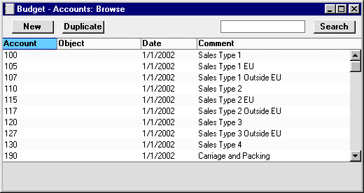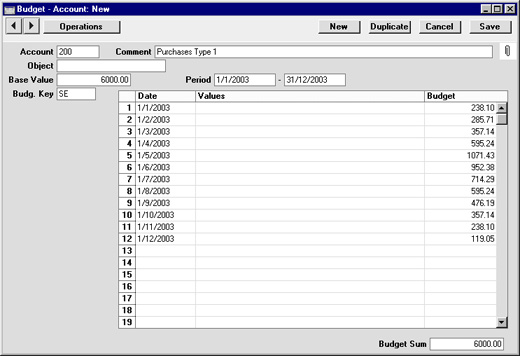Entering Budgets
- In the Nominal Ledger module, select 'Budgets' from the Registers menu (or click [Budgets] in the Master Control panel).
The 'Budget - Accounts: Browse' window is opened, showing those Accounts for which Budgets have already been entered. A separate Budget record should be created for each Account for a particular fiscal year. If you are using Objects, separate Budget records can be entered for each Account/Object combination: this can be useful if the Objects represent different departments which have separate budgets.

- Click [New] in the Button Bar or highlight a Budget record similar to the one you want to enter and click [Duplicate] in the Button Bar.
The 'Budget - Account: New' window is opened, empty if you clicked [New] or containing a duplicate of the highlighted Budget record.

- Account
- Paste Special
Account register, Nominal Ledger/System module
- Enter the number of the Account for which you want to enter a Budget.
- Comment
- The Account name will be placed in this field by Hansa.
- Object
- Paste Special
Object register, Nominal Ledger/System module
- If you are creating the Budget for a certain Object, enter its Object Code here. This allows you easily to create Budgets for different departments.
- Period
- Enter the first and last date of the budget period.
- Base Value
- The expected total for the budget period. Remember to enter sales and income values, liabilities and equity as negative (credit) values, and assets and costs as positive (debit) values.
- The figure entered here can be treated as a control total for the period. If the period is a year, for example, the figure can be broken down into monthly or quarterly totals in the grid area. These can be entered manually, working to the Base Value as a target, or they can be calculated from the Base Value using a Budget Key, specified in the next field.
- Budg. Key
- Paste Special
Budget Keys setting, Nominal Ledger
- The Budget Key is a useful tool for breaking an annual budget figure down to monthly totals if that process can be carried out using a formula. For example, experience may show that sales of a particular product always follow a set pattern with a certain percentage in each month. Alternatively, and more simply, a Budget Key can be used to break an annual rent figure down into twelve equal divisions.
- The setting up of Budget Keys is fully described here.
- To apply a Budget Key to a Budget record, it is first necessary to enter a figure to the Base Value field. This figure should represent the budget for the whole period (perhaps a year). Then, specify an appropriate Budget Key and enter the start dates of each month or quarter on separate rows in the grid area. You should have the same number of period divisions (i.e. rows in the grid) as you have entered for the Budget Key. Then, choose 'Recalculate' from the Operations menu. For each row, a total (i.e. a monthly or quarterly total) will appear in the grid area. These will be calculated by apportioning the Base Value according to the ratios in the Budget Key. Finally, save the record.
- Date
- In the grid area, enter the start date for each of the budget periods you want to enter. Any number of periods can be used, but, if you are using a Budget Key, you should have the same number as you have entered for the Budget Key. If the Budget and Budget Keys have different numbers of periods, the Base Value and Budget Sum figures will not match after the 'Recalculate' function has been used.
- A date must be entered for each budget period. To save labour and reduce the chance for error, the easiest way to enter Budget records is to use the [Duplicate] button to copy a Budget record with the dates already entered.
- Values
- Enter absolute values for each period.
- If no Budget Key has been specified, these Values will be moved to the right-hand column as soon as you select 'Recalculate' from the Operations menu.
- If a Budget Key and Base Value have been specified, these Values will be treated as extra amounts to be added to the calculated figures in the right-hand column when the 'Recalculate' function is used.
- Budget
- Hansa will calculate this value for you when you select the 'Recalculate' command from the Operations menu.
- Budget Sum
- This field shows the total budget for the year. Unlike the figure entered to the Base Value field, this figure is calculated by Hansa as a sum of the Budget figures in the grid. Therefore, if the Budget is revised and recalculated using the 'Recalculate' function on the Operations menu, the Base Value will remain unchanged, so some comparison can be made between the original budgeted figure and the final one. The Budget Sum will also take into account any extra amounts in the Values column.
- If the difference between the Base Value and the Budget Sum cannot be explained, the probable cause is that the Budget has a different number of periods (rows in the grid) to the Budget Key.
- When Values have been entered for all rows in the grid, or a Budget Key has been chosen, select 'Recalculate' from the Operations menu and click [Save] to save, or [Cancel] to cancel.
- Repeat steps 1 to 3 to set Budgets for all Account/Object combinations. Use the [Duplicate] button to assist with the data entry. Only one Budget record can be saved for each Account/Object/Period combination.
! | For Budget figures to appear in Nominal Ledger reports for comparison purposes, at least one entry with a date must be made to the grid area of the Budget screen. | |
- Once this has been done, you might want to set an overall Budget for each Account (i.e. the sum of the separate Budgets for each Object). To do this, create a new Budget record and enter the Account and Period. Save the record and then select 'Calculate Sum from Account-Object Budget' from the Operations menu. Hansa will search for all Budgets featuring the Account with the various Objects that fall in the relevant Period and calculate an overall Budget by adding them together.
- Three reports can be used to compare Budgets and Revised Budgets with actual figures: the Balance Sheet, the Object/Quantity report (which provides this analysis separately for each Object/Account combination) and the Profit & Loss report.
|